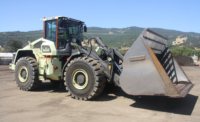A small precast-concrete bridge in New Jersey is being replaced with a hybrid-composite beam structure that could have a service life of 100 years. This is the third project using the technology, which combines a glass-fiber reinforced shell, self-consolidating concrete for compression reinforcement and high-strength continuous steel fibers for tension reinforcement.

HC Bridge Co. LLC, Chicago, is supplying beams for the $1.34-million state Rte. 23 Peckman’s Brook Bridge in Cedar Grove, N.J. The 50-year-old four- lane, 66-ft-wide, 30-ft-long bridge is considered structurally deficient and is being replaced with composite beams manufactured by Harbor Technologies LLC, Brunswick, Maine. The first stage, consisting of six beams, was installed by Ritacco Construction Inc., Belleville, N.J., using only an excavator.
Once in place, the beams are joined with high-strength polymer adhesive and filled with 13 cu yd of concrete. After installing the deck, parapets and back spans, the other half of the bridge will be replaced. “Where we see the most benefit is you don’t need heavy equipment. Each beam weighs only 2,200-lb. without concrete,” says Tony Ritacco, owner of Ritacco Construction. “The erection time is about the same as pre-stressed concrete but much less than steel because there is no cross-bracing or deck pans.”
The New Jersey Dept. of Transportation received a $200,000 federal grant to use the hybrid-composite beams. “They are lighter in weight, corrosion-resistant and reduce maintenance costs while increasing lifespan,” says NJDOT spokeswoman Erin Phalon. “Also, they can be built quickly, reducing traffic congestion.” She notes there will be no weight limit on the structure when it is completed at the end of the year.
John R. Hillman, founder and president of HC Bridge, invented the beam in 1996 after wondering what would happen if he combined concrete and steel with a composite material. “Together, they result in a tied arch,” he says. After years of raising research funds, developing and testing the manufacturing process and finally convincing an owner to try it, he notes, “There are numerous obstacles in our industry that make this kind of quantum leap in technology difficult for a designer or owner.” With tests going well, Hillman says, “My vision is to establish equivalency with precast and steel components so we can facilitate direct substitution on bridges worldwide.”
The first hybrid-composite project was a 30-ft-long prototype rail bridge that is still being tested in Pueblo, Colo. (ENR 2/18/08 p. 18). The second was the $2-million, 57-ft-long High Road Bridge in Lockport Township, Ill. Coming soon is the Knickerbocker Bridge in Boothbay, Maine, an eight-span, 540-ft-long, 32-ft- wide $6-million replacement structure.
“The current structure is a two-lane timber bridge with timber bents,” says Nathaniel D. Benoit, Maine DOT project manager. “The original timber piles are deteriorating due to marine borers, so it is structurally deficient.” Because the bridge is only about 4 ft above the saltwater at high tide, Maine DOT wanted a structure that will perform well in a marine environment. The agency believes hybrid composites will outperform traditional steel and concrete. Also at issue are equipment mobilization problems due to beam weight.
This month, Maine DOT will advertise the project for a fall 2011 completion. The job includes driving 35 24-in-dia. rock-anchored steel-pipe piles 30-ft to 70-ft deep. The hybrid-composite beams are 2-ft wide but support a 4-ft wide top plate that will serve as a stay-in-place form for deck placement. “We think a medium-sized contractor should be able to do the work,” says Benoit. “Material costs are slightly higher, but erection and substructure costs are less. The real saving is in long-term maintenance".


